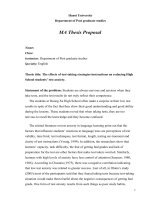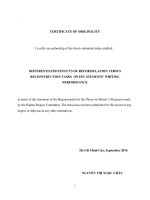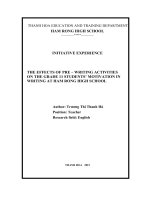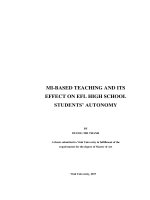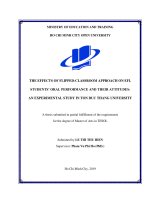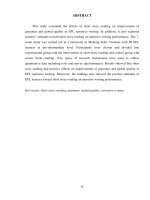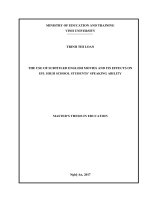Effects of video making projects on efl high school students’vocabulary retention and learning motivation
Bạn đang xem bản rút gọn của tài liệu. Xem và tải ngay bản đầy đủ của tài liệu tại đây (1.42 MB, 106 trang )
MINISTRY OF EDUCATION AND TRAINING
QUY NHON UNIVERSITY
TRAN THI PHUONG THAO
EFFECTS OF VIDEO-MAKING PROJECTS ON
EFL HIGH SCHOOL STUDENTS’
VOCABULARY RETENTION AND LEARNING
MOTIVATION
Major: Theory and Methodology of English Language Teaching
Code: 8140111
Supervisor: Assoc. Prof. Dr. Nguyen Quang Ngoan
BINH DINH – 2023
BỘ GIÁO DỤC VÀ ĐÀO TẠO
TRƯỜNG ĐẠI HỌC QUY NHƠN
TRẦN THỊ PHƯƠNG THẢO
TÁC ĐỘNG CỦA DỰ ÁN LÀM VIDEO ĐẾN
VIỆC GHI NHỚ TỪ VỰNG TIẾNG ANH VÀ
ĐỘNG LỰC HỌC TẬP CỦA HỌC SINH THPT
Ngành: Lý luận và phương pháp dạy học bộ môn Tiếng Anh
Mã số: 8140111
Người hướng dẫn: PGS. TS. Nguyễn Quang Ngoạn
BÌNH ĐỊNH – 2023
i
STATEMENT OF ORIGINALITY
I, Tran Thi Phuong Thao, guarantee that the research paper entitled “Effects of Video-
Making Projects on EFL High School Students’ Vocabulary Retention and Learning
Motivation” has never been submitted for the award of any degree or previously
published by another person, except where due references are made. This research is
the result of my own work and effort, so it is my original work.
Binh Dinh, October 2023
Tran Thi Phuong Thao
ii
ACKNOWLEDGEMENT
I would like to acknowledge and give my sincere thanks to my supervisor, Assoc.
Prof. Dr. Nguyen Quang Ngoan, who made this work possible. His guidance and
advice carried me through all the stages of writing my project. I would also like to
thank my committee members for letting my defense be an enjoyable moment, and for
giving your brilliant comments and suggestions, thanks to you.
I would also like to give special thanks to my husband, To Trong Quoc, and my family
as a whole for their continuous support and understanding when undertaking my
research and writing my project. Your prayer for me was what sustained me this far.
Finally, I would like to thank students from classes 11B4 and 11B7 from Pham Van
Dong High School, for following my directions and letting me conduct the
experimental research. You performed and cooperated excellently, and I believe you
will be more successful and fortunate with your path of conquering English if you
never stop trying day by day.
iii
TABLE OF CONTENTS
STATEMENT OF ORIGINALITY .................................................................................i
ACKNOWLEDGEMENT.............................................................................................. ii
TABLE OF CONTENTS .............................................................................................. iii
TÓM LƯỢC ...................................................................................................................vi
ABSTRACT ................................................................................................................. vii
LIST OF ABBREVIATION........................................................................................ viii
LIST OF TABLES..........................................................................................................ix
LIST OF FIGURES .........................................................................................................x
CHAPTER 1: INTRODUCTION....................................................................................1
1.1. Rationale ...............................................................................................................1
1.1.1. Theoretical reasons ........................................................................................1
1.1.2. Contextual reasons.........................................................................................2
1.2. Research aim and objectives .................................................................................3
1.2.1. Aim .................................................................................................................3
1.2.2. Objectives .......................................................................................................3
1.3. Research questions................................................................................................4
1.4. Scope of the study.................................................................................................4
1.5. Significance of the study.......................................................................................4
1.6. Structure of the thesis............................................................................................4
CHAPTER 2: LITERATURE REVIEW.........................................................................6
2.1. Vocabulary............................................................................................................6
2.1.1. Definition of vocabulary ................................................................................6
2.1.2. The importance of vocabulary .......................................................................7
iv
2.1.3. Vocabulary teaching and learning.................................................................8
2.1.4. Vocabulary retention....................................................................................11
2.2. Motivation...........................................................................................................13
2.2.1. Definition of motivation ...............................................................................13
2.2.2. Motivation in English vocabulary learning .................................................14
2.3. Project-based learning and digital video-making projects..................................15
2.4. Benefits of digital video-making projects in English language learning............18
2.5. Related studies on using video-making projects in L2 teaching and learning ...18
2.6. Justification of the study .....................................................................................24
CHAPTER 3: METHODOLOGY.................................................................................26
3.1. Research design ..................................................................................................26
3.2. Research setting and participants........................................................................27
3.3. Materials .............................................................................................................28
3.3.1. The course book (Tieng Anh 11 for the seven-year curriculum) for formal
face-to-face instruction ..........................................................................................28
3.3.2. Video-making activities employed in the intervention time .........................29
3.4. Instruments to collect data ..................................................................................32
3.4.1. Vocabulary paper tests.................................................................................32
3.4.2. Questionnaire ...............................................................................................33
3.4.3. Interview.......................................................................................................35
3.5. Procedures for data collection and analysis ........................................................35
CHAPTER 4: RESULTS AND DISCUSSION ............................................................37
4.1. Students’ vocabulary retention before and after the intervention.......................37
4.1.1. Vocabulary pre-test and post-test results of the control group ...................37
4.1.2. Vocabulary pre-test and post-test results of the experimental group ..........38
v
4.1.3. Pre-test results of the control group and experimental group.....................40
4.1.4. Post-test results of the control group and experimental group ...................42
4.1.5. Students’ performance on the delayed vocabulary post-test .......................45
4.1.6. A comparison of the vocabulary test scores of the two groups....................47
4.2. Students’ learning motivation after the intervention ..........................................48
4.2.1. Results from the questionnaire.....................................................................48
4.2.1.1. Students’ interest in the content of the activities oriented for video-
making projects ..................................................................................................48
4.2.1.2. Students’ attitudes and motivation for video project assignments ........52
4.2.2. Results from the interview............................................................................56
4.2.2.1. Students’ perceptions on the use of video-making projects ..................56
4.2.2.2. Students’ motivation in vocabulary learning under the use of video-
making projects ..................................................................................................57
4.3. Discussion ...........................................................................................................60
CHAPTER 5: CONCLUSION ......................................................................................62
5.1. Conclusions.........................................................................................................62
5.2. Pedagogical implications ....................................................................................63
5.3. Limitations of the study ......................................................................................63
5.4. Recommendations for further research...............................................................64
REFERENCES ..............................................................................................................65
APPENDICES ...............................................................................................................71
APPENDIX A: VOCABULARY TESTS .................................................................71
APPENDIX B: QUESTIONNAIRE..........................................................................81
APPENDIX C: INTERVIEW QUESTIONS ............................................................89
APPENDIX D: TRANSCRIPTION OF THE INTERVIEW ....................................90
vi
TÓM LƯỢC
Dự án làm video như một hoạt động sau giờ học nhằm nâng cao sự tự tin trong giao
tiếp tiếng Anh của người học đã được áp dụng rộng rãi ở nhiều cơ sở giáo dục tư thục
ở Việt Nam. Nhiều giáo viên cũng sử dụng phương pháp này trong các lớp học trực
tuyến của mình để giúp người học ghi nhớ từ vựng tiếng Anh và có động lực hơn. Mặc
dù các dự án làm video được áp dụng rộng rãi và đưa ra một số kết luận liên quan, vẫn
cần phải xác nhận xem các kết luận của nghiên cứu này khi đặt trong bối cảnh các
trường công lập ở Việt Nam cho đến nay có phù hợp khơng hay như các phát hiện mới
có tương hợp kết luận trong các nghiên cứu trước đó khơng. Nghiên cứu mơ tả và thực
nghiệm này được thực hiện để tìm hiểu tác động của các dự án làm video đối với khả
năng ghi nhớ từ vựng và động lực học tập của học sinh trung học phổ thông học tiếng
Anh như một ngoại ngữ. Để cung cấp đủ dữ liệu định lượng và định tính cho việc kết
luận nghiên cứu, ba công cụ nghiên cứu là bài kiểm tra từ vựng, bảng câu hỏi khảo sát
và phỏng vấn đã được sử dụng trên 70 học sinh trung học phổ thông thuộc hai lớp của
một trường trung học công lập ở vùng nông thôn tỉnh Phú Yên. Kết quả thu thập được
từ các bài kiểm tra cho thấy, nhóm học sinh thực nghiệm tham gia làm video có kết
quả tốt hơn so với nhóm học sinh được giáo viên áp dụng phương pháp truyền thống.
Bên cạnh đó, dữ liệu từ bảng câu hỏi và phỏng vấn cho thấy các dự án làm video đã
giúp làm tăng sự hứng thú của học sinh và thúc đẩy các em học từ vựng. Do đó, có thể
đề xuất rằng dự án làm video nên được triển khai trong lớp học tiếng Anh để giúp
nâng cao khả năng ghi nhớ từ vựng và động cơ học tập của học sinh.
vii
ABSTRACT
Video-making projects as after-school activities to enhance learners’ confidence in
communicating in English have widely been applied in many private Vietnamese
institutions. Many teachers also use this method in their online classes to help learners
retain English vocabulary and be more motivated. Despite the spreading use of video-
making projects and the release of several relevant conclusions in this field, there is
still a need to confirm whether the results of this study which was set in the context of
public schools in Vietnam are hitherto matched the previous ones conducted in other
contexts. Therefore, the combined experimental and descriptive study was conducted
to find out the effects of video-making projects on EFL high school students’
vocabulary retention and learning motivation. In order to supply enough quantitative
and qualitative data for the conclusion of the study, three research instruments namely
vocabulary tests, a questionnaire, and an interview were employed on 70 EFL high
school students in 2 classes of a public high school in the countryside of Phu Yen
Province. The results collected from the tests indicated that the experimental group’s
students had better results than those whose teacher used the traditional methods.
Besides, the data from the questionnaire and interviews showed that the video-making
projects increased students’ interest and motivated them to learn vocabulary. It can
thus be suggested that video-making projects should be implemented in English
classrooms to help enhance students’ vocabulary retention and learning motivation.
Keywords: video-making projects, English vocabulary, retention, learning
motivation, EFL high school students, Vietnam.
viii
LIST OF ABBREVIATION
CG: Control group
DVMPs: Digital video-making projects
EFL: English as a foreign language
EG: Experimental group
ICT: Information communications technology
L2: second language
MOET: Ministry of Education and Training
PBL: Project-based learning
SLA: Second language acquisition
ix
LIST OF TABLES
Table 3.1. Students’ General Information .....................................................................27
Table 3.2. Instructions for Video-Making Projects .......................................................29
Table 3.3. Reliability Statistics of the Questionnaire ....................................................34
Table 4.1. Descriptive Statistics of CG's Vocabulary Tests ..........................................37
Table 4.2. Results of Paired Sample T-test for CG's Vocabulary Pre-test and Post-test
....................................................................................................................................... 38
Table 4.3. Descriptive Statistics of EG's Vocabulary Tests ..........................................38
Table 4.4. Results of Paired Sample T-test for EG's Vocabulary Pre-test and Post-test
....................................................................................................................................... 39
Table 4.5. Descriptive Statistics of Vocabulary Pre-Test Scores of the Two Groups ..40
Table 4.6. Results of Independent Samples T-test of the Vocabulary Pre-test Scores .41
Table 4.7. Descriptive Statistics of Vocabulary Post-Test Scores of the Two Groups.42
Table 4.8. Results of Independent Samples T-test of the Vocabulary Post-test Scores44
Table 4.9. Descriptive Statistics of Delayed Vocabulary Post-Test Scores of the Two
Groups............................................................................................................................45
Table 4.10. Results of Independent Samples T-test of the Delayed Vocabulary Post-
test Scores ......................................................................................................................46
Table 4.11. Descriptive Statistics of Students' Interest in the Content of the Video-
Making Activities ..........................................................................................................50
Table 4.12. Descriptive Statistics of Students' Attitudes and Motivation for Video
Project Assignments ......................................................................................................52
x
LIST OF FIGURES
Figure 4.1. Comparison of Means of the Two Groups ..................................................47
Figure 4.2. Students' Interest in the Content of the Video-Making Activities ..............51
Figure 4.3. Students’ Attitudes and Motivation for Video Project Assignments ..........54
1
CHAPTER 1: INTRODUCTION
Chapter 1 introduces the rationale underlying this current study.
The chapter includes 6 main parts: 1) the rationale, 2) the aim
and objectives of the study, 3) research questions, 4) scope of the
study, 5) the significance of the study, and 6) the structure of the
study.
1.1. Rationale
1.1.1. Theoretical reasons
Vocabulary acquisition is regarded as the initial and fundamental stage in
second language teaching and learning. More specifically, an individual possessing
a rich vocabulary can not only improve his second language skills but also advance
his proficiency in the language (Horwitz, 1988; Schmitt, 2000). Recognizing the
importance of vocabulary retention in one’s second language learning, researchers
have been attracted to and stimulated to do experimentation and draw conclusions
on creative activities or teaching methods that can increase vocabulary retention.
With the advent of technology, studies in the field have expanded. The rapid
development of technology has enhanced productive ways to teach and learn second
language vocabulary, opening up numerous alternatives to facilitate vocabulary
teaching and learning practices (Dana, 2010; Kern, 2006; Nikitina, 2009; Stepp-
Greany, 2002). In addition, today’s and future’s young generations are accustomed
to the active life associated with smart devices, so traditional language classes and
conventional after-school assignments are no longer really appropriate and can
decelerate second language learning progress. Face-to-face classes with smart
devices have been applied in various institutions, but the completion of homework
in groups with smart devices to motivate self-study at home and strengthen
vocabulary has not been witnessed extensively. Besides the use of technology,
teachers’ orientation of good fun after-school assignments is essential. Therefore,
2
many teachers in institutions such as private schools, online language classes and
foreign language centres have learners carry out after-class video-making projects
individually or in groups to boost students’ vocabulary learning.
Very few studies have been conducted in the field of vocabulary retention and
learning motivation resulted from after-school video-making projects. As a result, to
fulfil the remaining research gap concerning the role of homework instructions in
improving learners’ English vocabulary in the context of high schools in Vietnam,
this study aims to explore how after-school video-making projects influence EFL
high school students’ vocabulary retention and learning motivation.
1.1.2. Contextual reasons
Investing in English learning for children is becoming a trend among today’s
young parents in Vietnam as the ability to communicate in English well brings
many benefits. The Vietnamese Ministry of Education and Training (MOET) has
been encouraging the younger generation to learn English by making English a
compulsory subject in schools. The implementation of teaching and learning
English in our country encounters many difficulties, making the set goals not
achieved as desired. One of the biggest challenges is the limited time spent on
formal face-to-face instruction in public schools. Actually, parents with abundant
financial resources can support their children’s English skills by sending them to
language centres or tutors’ homes where students receive further English practice
after school. Nevertheless, the majority of Vietnamese children whose parents live
in the countryside or have low income do not have opportunities to be assisted with
further English practice after school, especially the practice of English vocabulary.
It is inferred that the main source of support for English skills is to attend school. In
public schools, the big size of classes, the differences in students’ English
proficiency and limited practice time have become obstacles on the enthusiasts’
path of conquering the English language. For learners, the most demotivating time
is trying to memorize English vocabulary before the class begins. Also, one of the
most common complaints from teachers is that students find it difficult to retain
3
vocabulary while the lessons carry on going by and the number of words to recall
piles up. Understanding teachers’ stress in class, MOET has organized pieces of
training for teachers and encouraged them to creatively design exciting tasks for
students and improve vocabulary teaching quality by integrating inspirational
activities and technology. Numerous recommended innovative methods are for
face-to-face instruction in class while little attention has been paid to the
introduction of projects as after-class assignments with the use of technology such
as student-produced videos. Apparently, the time for face-to-face instruction in
class is only enough for the provision of basic knowledge, and educators desire
learners to spend more time self-studying after class so that learners can retain L2
vocabulary the most effectively. Therefore, student orientation and support for
motivating self-study after-school are required.
Personally, I have a great interest in applying learner-produced video
projects and once had some secondary students do it for the sake of their speaking
practice. In the meantime, the high school students in my institution seem to feel
less keen to learn English vocabulary. This flashed in my mind the wonder if self-
recording videos could help learners with their English vocabulary retention. It is
necessary for the study to be implemented so that its results can support teachers of
English in the vicinity.
1.2. Research aim and objectives
1.2.1. Aim
The study is to investigate the effects of video-making projects on English
vocabulary learning of EFL high school students.
1.2.2. Objectives
- To examine the effects of video-making projects on EFL high school students’
vocabulary retention.
- To reveal EFL high school students’ motivation level as a result of the
implementation of video-making projects.
4
1.3. Research questions
The two research questions focused on in the study are:
1. To what extent do video-making projects affect EFL high school students’
vocabulary retention?
2. How much are EFL high school students motivated when learning with
video-making projects?
1.4. Scope of the study
Owing to the time constraint and other practical conditions, the study could
only be conducted on a limited number of participants in a public school in the
countryside of Phu Yen Province. There were only 70 students from two classes of
Grade 11. Because of the school’s assignment to the researcher, the material was the
course book called Tieng Anh 11 for the seven-year English curriculum. The
restriction was that the promulgation of reforms of MOET and the release of new
course-books made the textbook no longer be used in any official public school in
Viet Nam in the next school year. Also, the vocabulary of four units (units 9, 10, 11
and 12) in the course book was included due to the time frame of the research.
1.5. Significance of the study
The results of the study are expected to make a considerable contribution to
the research concerning vocabulary learning through video-making projects, helping
later researchers have more sources of references and giving them the opportunities
to fulfil the limitations of this research or produce further valuable studies. More
significantly, the study may assist a number of teachers who are hesitating about
whether to apply or how to apply properly video-making projects in English classes
properly to promote English vocabulary teaching and learning.
1.6. Structure of the thesis
The report of the results is demonstrated in five basic chapters: Introduction,
Literature Review, Methodology, Results and Discussion, and Conclusion.
5
Chapter one presents the general information of the study. There are the
reasons, aim and objectives of the research, the research questions, the scope, the
significance, and the intended structure of the thesis comprised.
Chapter two supplies some theoretical background knowledge as a basis for
the study. It reviews the literature concerning 1) vocabulary teaching and retention,
2) motivation in English vocabulary learning, 3) digital video project-based
learning, 4) benefits of student-generated videos in English language learning, 5)
related studies on using video-making projects in English language learning, and 6)
justification of the current study.
Chapter three clarifies the methodology employed to supply reliable data for
the conclusions of the study. Firstly, it claims the design of the current study.
Secondly, the setting and participants are described. Thirdly, it depicts the materials
of the course and the stages to conduct the study. Fourthly, it lists the instruments
used to collect data. Finally, it presents the procedures for the data collection and
analysis.
Chapter four reports the findings by giving a specific analysis of the data.
First, the reliability and validity of the samples and instruments are shown. Next,
the effects of video-making projects on EFL high school students’ vocabulary
retention and learning motivation are described via collected quantitative and
qualitative data. Then the findings are interpreted and discussed in reference to the
previous studies.
Chapter five gives conclusions to the study. The chapter also contains the
implications for English language teaching. Lastly, it ends with the limiatations of
the study and suggestions for further studies.
6
CHAPTER 2: LITERATURE REVIEW
The purpose of this study is to examine the effect of video-making
projects on students’ vocabulary retention and motivation. Thus,
this chapter reviews the literature knowledge related to 1)
vocabulary teaching and retention, 2) motivation in English
vocabulary learning, 3) digital video project-based learning, 4)
benefits of student-generated videos in English language
learning, 5) related studies on using video-making projects in
English language learning, and 6) justification of the current
study.
2.1. Vocabulary
2.1.1. Definition of vocabulary
There are various expressions for the definition of the term “vocabulary”. In the
dictionary, vocabulary is defined as all the words that a person knows or uses to talk
about a particular subject, all the words in a particular language, and a list of words
with their meanings, especially in a book for learning a foreign language (P.
Phillips, Francis, Webb, & Bull, 2010). Approving the definition of vocabulary in
the dictionary, Phillips (1993, p. 68) stated that vocabulary is “the collection of
words that an individual knows”. It is also added that vocabulary regarded as the
words of a language consists of single units or groups of words which convey a
specific meaning (Lewis, 1993). Vocabulary refers to knowledge of words and their
meanings (Butler et al., 2010).
From the definitions perceived by some authors, it can be seen that vocabulary
is a set of words that a person owns in his mind and uses to communicate with
others. Vocabulary is recognized in the form of a list of words with their meanings
in a book for language learners to refer and study.
7
2.1.2. The importance of vocabulary
Vocabulary plays a central role in language teaching and learning. Not only
teachers but also learners themselves are aware of the importance of vocabulary in
mastering a language. Without sufficient vocabulary language users “cannot
understand others or express their own ideas” (Ibrahim, 2015, p. 1) in any form
(spoken or written), so this leads to failure in language acquisition (Schmitt, 2000).
Without vocabulary, learners cannot master the four basic skills (listening,
speaking, reading and writing) and even feel challenged to start with the grammar.
It is obvious that lacking vocabulary knowledge negatively affects other language
skills (Gass, 1988). Many linguists believe that of all components that are necessary
for language learners to achieve, vocabulary knowledge is considered the main
factor to comprehend and convey messages. “While without grammar very little can
be conveyed, without vocabulary nothing can be conveyed” (Wilkins, 1972, pp.
111–112). This statement is true that many speakers have been seen not to produce
utterances with correct grammar, but still have others comprehend by an impaired
combination of words. Learners who spend much time working with grammar are
unable to make much progress in productive skills, but those who possess a wider
vocabulary and phrases can express more comprehensible messages despite very
little grammar (Thornbury, 2002). Schmitt and Jiang (2011) claimed that “learners
carry around dictionaries and not grammar books”. Lewis (1993, p. 89) considered
“lexis is the core or heart of language”. If the application of a language in real life is
a living body, language structures form the skeleton of the language while
vocabulary attaches flesh and other needed organs (Harmer, 2001). Words have a
close relation to other aspects of language use. Knowing a word means going
through other aspects concerning pronunciation, word structures, grammatical
properties, collocations and contextual factors (Nation, 2001; Schmitt, 2000). No
matter how good at grammar they are or fluently they communicate, it is crucial for
them to continue acquiring more productive vocabulary knowledge and improving
personal vocabulary learning tactics. Hence, vocabulary plays an important part in
mastering a language (Krashen, 1989).
8
Vocabulary is the key tool for langage acquisition and communication, whether
vocabulary is in foreign or native language. Without vocabulary, all language skills
and even grammar cannot be mastered. This has been witnessed and realized by
linguists via their paper and by teachers via their practical teaching. Thus, linguists
and language educators have continued supporting and appreciating the importance
of vocabulary in language teaching and learning. New strategies for vocabulary
learning and teaching have been updated and tested the effectiveness as the way this
research paper is conducted.
2.1.3. Vocabulary teaching and learning
Having a deep understanding of the importance of vocabulary in language
acquisition and academic performance, linguists and researchers have made
attempts to introduce feasible solutions for how vocabulary should be taught in the
classroom and what effective vocabulary teaching strategies are. Vocabulary cannot
be acquired instantaneously, but it expands and deepens throughout a lifetime.
Aspects of vocabulary cannot fully be mastered at once, and some aspects which
have been learnt may be forgotten (Cristina, 2010), so the vocabulary teaching job
is far more than looking up words in the dictionary for their meaning and using
them in sentences. The answer to the wonder of whether vocabulary instruction
should be incidental or intentional has been sought. Vocabulary is acquired
incidentally through implicit exposure to words and intentionally through explicit
instruction in specific words (selecting words to teach, and rich and robust
instruction) or word-learning strategies (dictionary use, morphemic analysis,
cognate awareness, and contextual analysis) (Linda & Linda, n.d.). In other words,
intentional vocabulary learning involves “any activity aiming at committing lexical
information to memory” (Koren, 1999, p. 2) and “investing the necessary mental
effort and memorizing the words until learners know their meanings” (Robinson,
2001, p. 271). In contrast, incidental vocabulary learning considers vocabulary
learning as “a byproduct of something else” such as reading a text for
comprehension or listening to local news (Gass & Selinker, 2001, p. 379). The two
